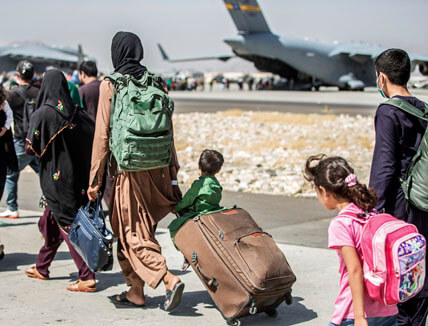
Families walk towards their flight during ongoing evacuations at Hamid Karzai International Airport, in Kabul, Afghanistan.
Located in south-central Asia, Afghanistan has a rugged terrain of deserts and mountains. Summers can be very hot and winters bitterly cold. It has historically been home to several ethnic groups and operated as a regional center of trade and culture. Islam is the official state religion of Afghanistan and an overwhelming majority of the population is Muslim. The different groups who live there have historically struggled with each other for control of the region, but they have struggled just as often with outsiders who sought to control the region.
As Afghanistan worked to establish a stable government in the 20th century, demonstrations, politically motivated arrests, and assassinations were not uncommon. A coup in 1973 was followed by another in 1978. The government established in 1978 had similar political ideals to the communist Soviet Union, but Afghan officials maintained that they were not controlled by the Soviet government. As unrest continued in Afghanistan, the Soviet Union invaded in December 1979. The Soviet Union claimed this action was necessary to support the communist Afghan government.
Several groups inside Afghanistan quickly united to oppose the Afghan military and their Soviet allies. These groups were known as mujahideen. The mujahideen also received volunteers and funding from Muslim countries. Other countries—including the United States—began to supply the mujahideen with weapons sent through Pakistan. In particular, shoulder-launched surface-to-air missiles began to devastate Soviet air power. As a result, the Afghan army could only fight the mujahideen to a stalemate even with the support of the Soviet military. By 1989, the last Soviet soldier had left Afghanistan.
After the Soviet exit, some factions of the mujahideen turned on each other. Different parts of Afghanistan were controlled by local warlords, and there was little security outside of the capital of Kabul. In 1994, a group known as the Taliban emerged in this environment. The Taliban were able to bring order to certain territories, but they never found broad support in the international community. The group holds extreme views on society and gender, and has a record of human rights abuses—particularly against women. By 2001 the Taliban controlled about 90 percent of Afghanistan and the country became haven for Muslim extremist groups.
One of those groups, al-Qaeda, planned and carried out the September 11, 2001 terrorist attack on the United States. In response, the United States and Great Britain launched a bombing campaign in Afghanistan that was followed by a ground assault. The Taliban government surrendered less than three months later on December 7, but the group’s armed forces continued to fight. U.S. troops remained in Afghanistan while new Afghan leaders tried to rebuild the government. In 2006 the North Atlantic Treaty Organization (NATO) sent forces to take over security operations in Afghanistan. The Taliban continued to carry out attacks and fought NATO to a stalemate.
By 2010, NATO leaders acknowledged that a military victory was not possible and planned to remove troops by 2014 and turn security operations over to the Afghan military. As NATO forces left, U.S. troops remained to train Afghan soldiers and support counterterrorism operations. In 2017, the United States increased its military presence in Afghanistan to boost the central government and stop Taliban progress, but Taliban advances continued. By late 2018 the United States announced plans to remove thousands of troops and began peace talks with the Taliban. Under the terms of an agreement reached in early 2020, the United States would withdraw all troops during a 14-month period and the Taliban would try to reach a peace agreement with the Afghan central government. Additionally, the Taliban would prevent al-Qaeda and ISIS from operating in Afghanistan.
The United States started removing forces in accordance with its agreement with the Taliban, but the Taliban and the Afghan government could not reach a peace agreement. As U.S. troops left parts of Afghanistan, the Taliban rapidly occupied those areas. The Afghan military failed to defend territory or respond in any meaningful way and by mid-August 2021 the Taliban controlled most of Afghanistan including the capital of Kabul.
The collapse of the Afghan military caught the United States off guard. U.S. forces secured the Kabul airport and began a tense evacuation of American forces, civilians, Afghan allies, and at-risk peoples beginning on August 14. On August 26, ISIS suicide bombers attacked the airport and killed 13 U.S. soldiers and over 60 Afghan civilians as evacuation efforts continued. Over the course of 17 days, the U.S.-led operation evacuated over 123,000 people. The last military transport left Afghanistan in the early hours of August 30, ending America’s 20-year war in Afghanistan—the longest war in American history. The Taliban is now in the process of establishing its government and the world waits to see if it will reinstate oppressive policies, or if it will be more moderate.
Image cedit: ©Sgt. Samuel Ruiz/U.S Marine Corps/AP Images
Sources
- Who are the Taliban and how did they take control of Afghanistan so swiftly?
(Source: CNN; accessed September 8, 2021) - Americans support Afghanistan pullout — but not the way it was done, a Post-ABC poll finds
(Source: The Washington Post; accessed September 8, 2021) - A Guide to the United States’ History of Recognition, Diplomatic, and Consular Relations, by Country, since 1776: Afghanistan
(Source: Department of State: Office of the Historian; accessed September 8, 2021)



